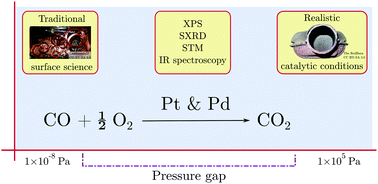当前位置:
X-MOL 学术
›
Chem. Soc. Rev.
›
论文详情
Our official English website, www.x-mol.net, welcomes your
feedback! (Note: you will need to create a separate account there.)
Surface science under reaction conditions: CO oxidation on Pt and Pd model catalysts
Chemical Society Reviews ( IF 40.4 ) Pub Date : 2017-06-07 00:00:00 , DOI: 10.1039/c7cs00045f Matthijs A. van Spronsen 1, 2, 3, 4 , Joost W. M. Frenken 5, 6, 7 , Irene M. N. Groot 7, 8, 9, 10
Chemical Society Reviews ( IF 40.4 ) Pub Date : 2017-06-07 00:00:00 , DOI: 10.1039/c7cs00045f Matthijs A. van Spronsen 1, 2, 3, 4 , Joost W. M. Frenken 5, 6, 7 , Irene M. N. Groot 7, 8, 9, 10
Affiliation

|
Platinum and palladium are frequently used as catalytic materials, for example for the oxidation of CO. This is one of the most widely studied reactions in the field of surface science. Although seemingly uncomplicated, it remains an active and interesting topic, which is partially explained by the push to conduct experiments on model systems under relevant reaction conditions. Recent developments in the surface-science methodology have allowed obtaining chemical and structural information on the active phase of model catalysts. Tools of the trade include near-ambient-pressure X-ray photoelectron spectroscopy, high-pressure scanning tunneling microscopy, high-pressure surface X-ray diffraction, and high-pressure vibrational spectroscopy. Interpretation is often aided by density functional theory in combination with thermodynamic and kinetic modeling. In this review, results for the catalytic oxidation of CO obtained by these techniques are compared. On several of the Pt and Pd surfaces, new structures develop in excess O2. For Pt, this requires a much larger excess of O2 than for Pd. Most of these structures also develop in pure O2 and are identified as (surface) oxides. A large body of evidence supports the conjecture that these oxides are more reactive than the corresponding O-covered metallic surfaces under similar conditions, although still debated in the literature. An outlook on this developing field, including directions that move away from CO oxidation towards more complex chemistry, concludes this review.
中文翻译:

反应条件下的表面科学:Pt和Pd模型催化剂上的CO氧化
铂和钯经常用作催化材料,例如用于CO的氧化。这是表面科学领域中研究最广泛的反应之一。尽管看似简单,但它仍然是一个活跃而有趣的主题,在相关反应条件下推动在模型系统上进行实验的部分解释了这一点。表面科学方法学的最新发展已允许获得有关模型催化剂活性相的化学和结构信息。商业工具包括近环境X射线光电子能谱,高压扫描隧道显微镜,高压表面X射线衍射和高压振动光谱。解释通常借助密度泛函理论与热力学和动力学模型相结合来进行。在这篇综述中,比较了通过这些技术获得的CO催化氧化的结果。在一些Pt和Pd表面上,会形成过量O的新结构2。对于Pt,这需要比Pd大得多的O 2过量。这些结构大多数也以纯O 2形式形成,并被识别为(表面)氧化物。尽管在文献中仍存在争议,但有大量证据支持这种推测,即在相似的条件下,这些氧化物比相应的O-覆盖的金属表面更具反应性。这篇综述总结了对这一发展领域的展望,包括从CO氧化转向更复杂化学的方向。
更新日期:2017-07-18
中文翻译:

反应条件下的表面科学:Pt和Pd模型催化剂上的CO氧化
铂和钯经常用作催化材料,例如用于CO的氧化。这是表面科学领域中研究最广泛的反应之一。尽管看似简单,但它仍然是一个活跃而有趣的主题,在相关反应条件下推动在模型系统上进行实验的部分解释了这一点。表面科学方法学的最新发展已允许获得有关模型催化剂活性相的化学和结构信息。商业工具包括近环境X射线光电子能谱,高压扫描隧道显微镜,高压表面X射线衍射和高压振动光谱。解释通常借助密度泛函理论与热力学和动力学模型相结合来进行。在这篇综述中,比较了通过这些技术获得的CO催化氧化的结果。在一些Pt和Pd表面上,会形成过量O的新结构2。对于Pt,这需要比Pd大得多的O 2过量。这些结构大多数也以纯O 2形式形成,并被识别为(表面)氧化物。尽管在文献中仍存在争议,但有大量证据支持这种推测,即在相似的条件下,这些氧化物比相应的O-覆盖的金属表面更具反应性。这篇综述总结了对这一发展领域的展望,包括从CO氧化转向更复杂化学的方向。











































 京公网安备 11010802027423号
京公网安备 11010802027423号